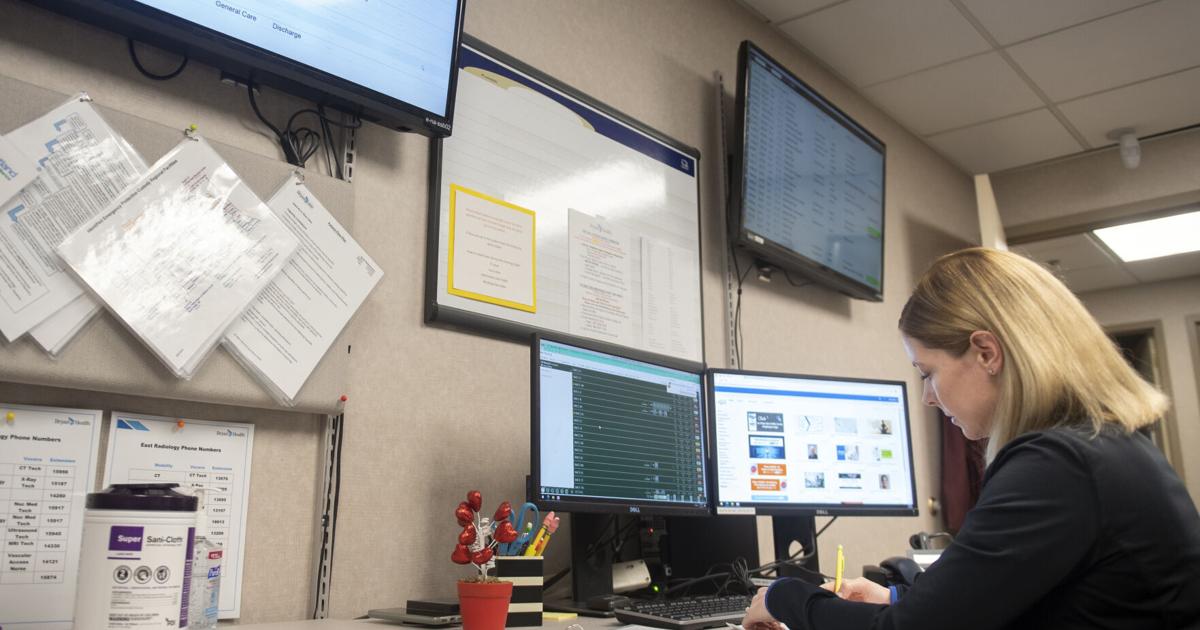[ad_1]

Patients with COVID-19 are filling only half the number of beds that they were at this time last year, which is good news for Nebraska’s hospital systems and the health care workers who are nearing the end of their third year dealing with the pandemic.
What’s not good news is that even with fewer COVID patients, hospitals in Lincoln and throughout Nebraska are still overflowing.

Trapp
Bryan Health set an all-time high for inpatients at its two Lincoln hospitals on Nov. 16, with 588, and has continued to see patient counts in the 570s and 580s on most days.
“We’re as full as we’ve ever been, even at the peak of COVID,” said Dr. John Trapp, Bryan’s chief medical officer. Trapp said that when the hospital has 580 or more patients, it means emergency departments at both hospitals are full with patients waiting on a permanent bed.
CHI St. Elizabeth in December had its most patient admissions in 18 months, while the CHI Health system as a whole cared for more patients than in any month in almost three years.
“It’s been very busy,” said Dr. Jason Kruger, the chief medical officer of St. Elizabeth in Lincoln.
At the Methodist Health System in Omaha, patient numbers so far in January are essentially the same as they were at this time last year, even though there are only about one-third as many COVID patients.
While patient surges linked to the pandemic have at times caused acute issues with hospital capacity, wider industry and structural issues have exacerbated a more chronic problem that existed before COVID hit.
Among them: an ongoing labor shortage, more demand for health care services by an aging population and an inability to discharge some patients who need after-hospital care.
It’s no secret that the nursing shortage that was already a problem before the pandemic has gotten much worse over the past three years as older nurses have chosen to retire and younger nurses have left due to burnout.
A Nebraska Hospital Association report last year predicted the state will be short nearly 5,500 nurses by 2025. There’s also a shortage of other critical health care workers, such as respiratory therapists and lab technicians, experts say.

Melissa Ostiguin, a registration team leader at admissions, works at the transfer center where staff members coordinate hospital beds at Bryan East Campus.
“You see a mass exodus of nurses and nurse assistants across the country. It’s not just our state or our region,” said Dr. Michael Ash, chief operations officer at Nebraska Medicine in Omaha.
Ash said surveys show that many nurses leave because they can get paid more working elsewhere, either as a traveling nurse or in another health care setting.
To combat that, he said Nebraska Medicine is spending $20 million on pay raises, shift differentials, sign-on bonuses and student loan forgiveness to help to recruit and retain staff.
The nursing shortage is an issue not just at hospitals, but also at many of the skilled nursing and rehabilitation facilities that take in patients who need longer-term care after a hospital stay for an illness or injury.
Staffing issues at those facilities mean fewer beds are available for patients to be discharged to, which is leading to further capacity issues at Nebraska’s hospitals.
Ash said Nebraska Medicine averages about 60 patients a day that it struggles to discharge to a skilled nursing or rehab facility.
Trapp said that, on a daily basis, about 10% of the patients at Bryan’s two Lincoln hospitals, “don’t need to be in the hospital, but for whatever reason they can’t be discharged.”
At CHI Health, Chief Medical Officer Dr. Cary Ward said that 10%-15% of its inpatients at any time are people awaiting a discharge to another health care facility. Earlier this month, those patients were collectively filling 300 beds.
But while the nursing shortage is a major factor in the difficulty in discharging patients to those post-acute facilities, it’s far from the only one.

Cary Ward
“I think it’s important to note that there’s more to the story than just the nursing shortage,” Ward said.
Some patients can’t be discharged to another facility because they are COVID-positive. Others might be waiting for approval from an insurance provider. And some have issues the nursing facilities don’t want to deal with, such as mental illness.
Another issue driving hospital capacity is the increased use of health care services. Even though there are fewer patients in the hospital linked to COVID, there are more people in the hospital for other reasons.
This fall hospitals were hit with an early surge in cases of flu and respiratory syncytial virus, which spiked early and hit numbers not seen in several years.
RSV cases began to climb in September, cresting in early November. That led to a surge of visits to emergency rooms.
The illness, which tends to hit very young children the hardest, led to spikes in hospitalizations at many of the state’s hospitals, including Children’s Hospital and Medical Center in Omaha.
Dr. Stephen Dolter said the hospital set an all-time record for patient admissions in October and then beat that mark by 10% in November.
Hospitals that deal more with adult patients saw big surges in November when flu cases peaked.

Randy Olson, a maintenance technician, works to construct an expanded holding area for patients who go to the emergency department at Bryan East Campus.
But it’s not just surges due to seasonal illnesses that are taxing hospitals. There has been a sustained increase in patient numbers across the board.
For example, Bryan had more than 96,000 people come to the emergency departments at its two hospitals in 2022. That was 15,000 more than in 2021 and the most the health system has ever recorded.
Chelsea Russell, a nurse manager in the Bryan West Campus emergency department, said that even as the pandemic has cooled, there has been no slowdown in visits to the ER, which is, “bursting at the seams.”
“We continue to see very high volumes every day in both of our emergency departments,” Russell said.
During the pandemic, Bryan added a dozen bed spaces in the hallways at each of its emergency departments to handle the overflow of patients, and those beds are routinely full, with patients who need to be admitted often waiting 24 hours or more to get a bed in a regular hospital room.
Bryan also is in the process of constructing a new holding area at its East Campus emergency department. The “results pending unit,” which is scheduled to open sometime next month, will have six bays for emergency department patients waiting on test results before discharge.
Spurring hospitals to make investments in innovative solutions to ease crowding may be one of the few positives of the pandemic.
Ward said CHI Health has been turning to its smaller critical-access hospitals in places like Schuyler and Nebraska City to take patients who can’t be discharged to a skilled nursing or rehab facility but no longer need hospital care. Moving the patients to the smaller hospitals frees up beds at hospitals in Omaha and Lincoln.
He said the hospital-to-hospital transfers have exceeded expectations and most patients are accepting of being transferred to a smaller hospital.
“They often find that they are extremely satisfied with the care,” Ward said.
Nebraska Methodist Health System has utilized similar procedures, sometimes moving patients from Methodist Hospital in Omaha to its locations in either Fremont or Council Bluffs, Iowa, to free up space, said Josie Abboud, president and CEO of Methodist Hospital and Methodist Women’s Hospital.
CHI Health also formed its own internal traveling nurse program to help deal with staff shortages and retain staff members who might otherwise leave.
And CHI, Bryan and other hospital systems have dedicated more resources to their transfer operations to try to help ensure they can find beds for patients who need to move from smaller hospitals to larger ones.
Other changes hospitals have made to alleviate overcrowding include the increased use of telemedicine and doing more surgeries on an outpatient basis.
Those innovations and others, along with the continued hard work of administrators, doctors and other staff, have helped to make sure hospitals over the past year have not had to take the same extreme measures as they did earlier in the pandemic, such as suspending elective surgeries.
There also have been investments made by the Legislature, drawing from federal COVID relief money the state received, including $10 million toward scholarships and student loan relief, $60 million for a rural health complex at the University of Nebraska at Kearney and another $60 million for workforce-related capital projects at the state’s community colleges.
But there is still more that needs to be done to provide a long-term solution.
“Hospital leaders feel that we’re going to be in this capacity challenge due to workforce issues for quite awhile,” said Jeremy Nordquist, president of the Nebraska Hospital Association.
On Thursday, the state’s hospitals along with the Nebraska Rural Health Association announced plans for the Nebraska Healthcare Workforce Collaborative, a group of industry organizations, hospital systems, and colleges and universities.
The group said its aim is to gather current data about the health care workforce, identify gaps and then align educational programs to meet the workforce needs for both the short and long term.
Nordquist said it’s going to be an important year in the Legislature when it comes to health care.
“We need a significant legislative effort this year on workforce,” he said.

Nancy Shook (left) and Sarah Vieth, house supervisors, work to manage the minute-to-minute puzzle of what beds are available at Bryan East Campus. Bryan Health set its all-time high for inpatients at its two Lincoln hospitals on Nov. 16, with 588.
There are other issues, too, that Nordquist believes the Legislature needs to tackle, such as increased Medicaid reimbursement.
Hospitals already are absorbing huge cost increases related to recruiting and retaining workers, as well as dealing with overall inflation. At the same time, more and more people are using public health insurance options, through either Medicaid or Medicare, that often don’t pay enough to allow hospitals to break even on the cost of the care they provide, he said.
Nordquist said that with the state sitting on a significant budget surplus — estimates show projected state revenues topping expenses by $1.9 billion for the two budget years that end June 30, 2025 — it’s “now or never” to spend the money necessary to solve Nebraska’s hospital capacity crisis.
“I think the state has enough resources to address Gov. Pillen’s priorities … as well as taking care of some of these other urgent health care priorities that we’re seeing in hospitals and nursing homes,” he said.
“This is our one bite at the apple with the revenues that we have right now, so it’s really the time to ask.”
Reach the writer at 402-473-2647 or molberding@journalstar.com.
On Twitter @LincolnBizBuzz.
[ad_2]
Source link



















